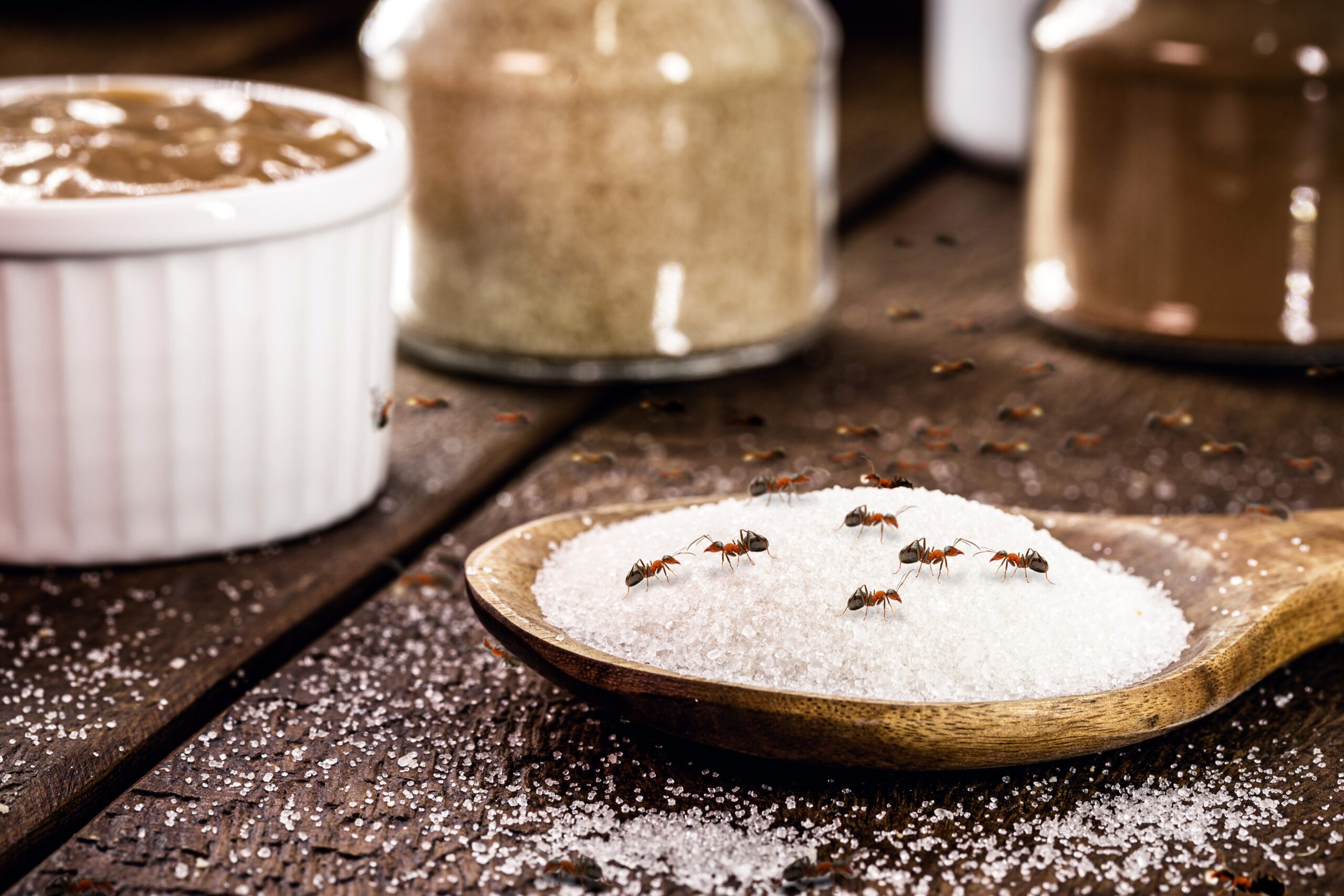It’s no secret that pests have a taste for our food. A pest invasion can ruin enough new groceries to make you wonder if the shopping trip you just went on was worth it. You may notice a trend with the diets of these voracious pests. Many of them, given the choice, tend to invade foods and drinks with high sugar content. But why are there so many pests with a sweet tooth? Let’s look at 6 different pests that have a craving for sweets and why even these tiny creatures can have dining preferences.
Ants
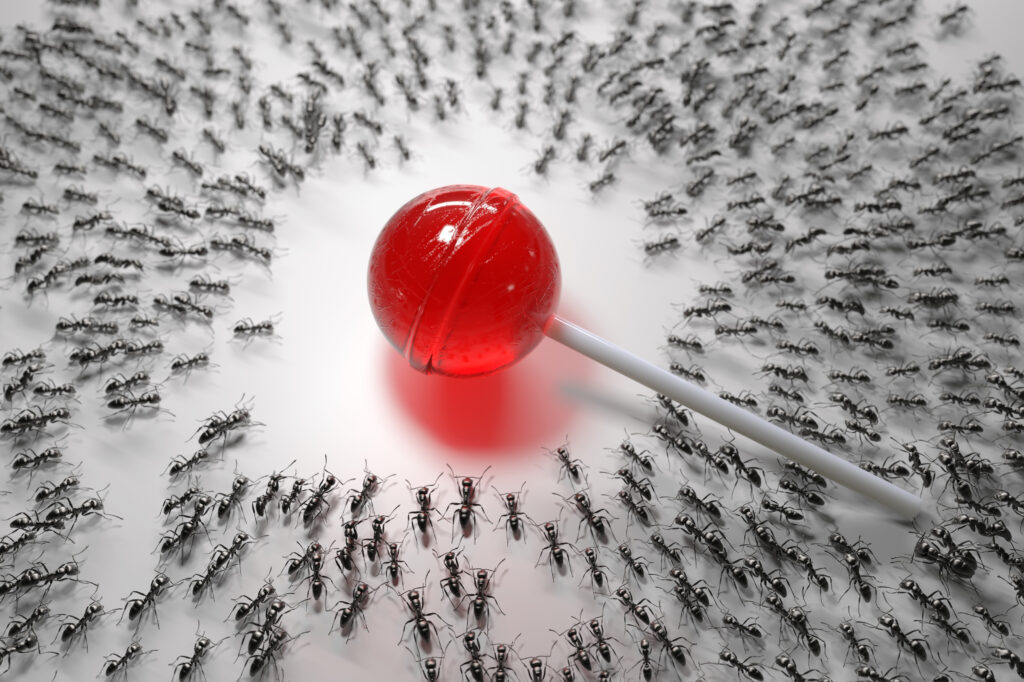
If we had to name the top food pest, ants would definitely be in the running. They are known for their ability to invade our foods while leaving a trail of pheromones (invisible scent chemicals) for their fellow workers to follow. Ants are exceptional at detecting glucose, which is how they find food that has not been sealed properly.
Anything that has a decent amount of sugar will be appealing to ants of various species, as the sugar gives them energy to continue working and serving their colony. They are not picky, but ants seem to prefer sweet syrups, jams, baked goods, and soft drinks. Keeping a clean kitchen is the best way to prevent these pests from making your home their own, as ants can live off of spills and crumbs for a long time.
When reading about ants who have a major sweet tooth, sugar ants were likely the first ones to pop in your head. There is a species of ant called “sugar ants,” but they are not commonly found in the residential U.S. It is more of a generic term people use to describe any ant that loves sugar, which is just about every kind. Some of the most common types are odorous house ants, pavement ants, and carpenter ants.
Sugar ants eat any sugary substance they can find inside or outside, and they use the aforementioned pheromones to lead the other worker ants to the prime food source. It can be as glorious as a whole tray of baked goods or as small as the sweet honeydew left on leaves from aphids. No matter what the source is, you can be sure that ants will make their way to the sugariest food they can find!
Roaches

Considered the garbage disposals of the pest world, roaches will eat just about anything in sight. Sometimes it’s actual food from our kitchens or meals that they happen to stumble upon. Other times, it is a material item that contains some organic ingredients, like cardboard or book pages. But when roaches don’t have these options available, they turn to disgusting options, like trash and actual waste. Roaches generally enjoy anything with starches and sweets. Items that are either organic or made from something living particularly stand out to them. They have a great sense of smell, which is surprising considering they prefer to live in terrible places, like the sewers and dumpsters.
Roaches like desserts, fruits, and cereals, as all of them have the preferable sugar content. But there is a caveat to the sweet tooth of roaches. They have adapted over time to lessen their desire for anything sweet, as it has backfired on them in the past. Many roach baits were made with this sweet craving in mind and were therefore incredibly sweet. Roaches fell for it enough times that their descendants learned to avoid anything sweet in order to run less of a risk of being eliminated. So roaches may not partake in as many sweet treats as they used to, but they still naturally lean towards the sweeter end of the spectrum with their diets.
Bees
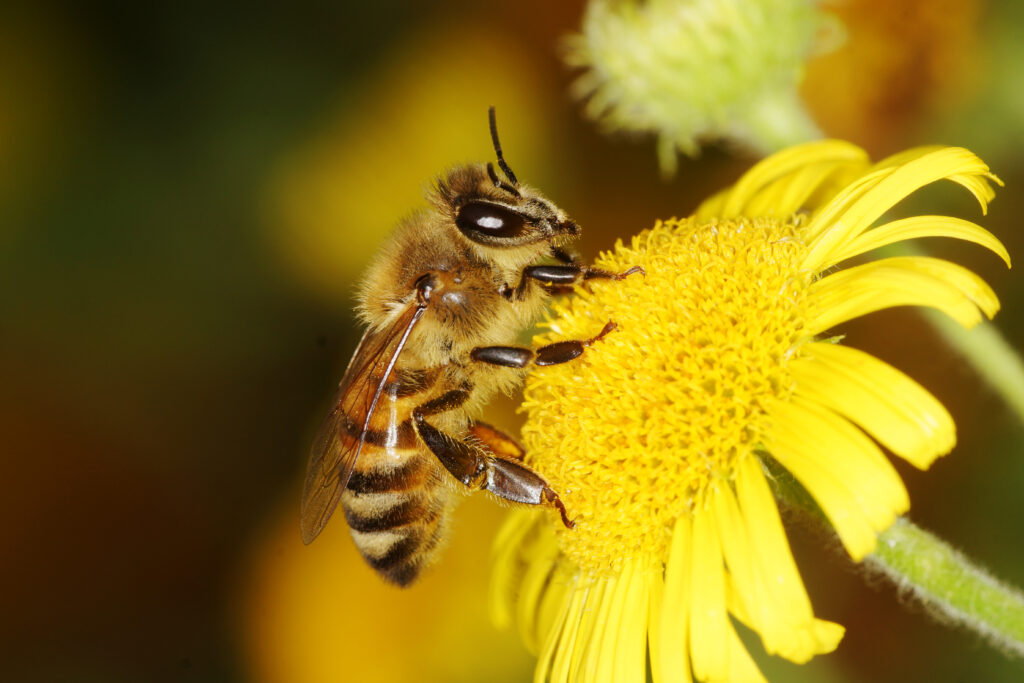
Since bees essentially only live off of sweet things, it makes sense that they would have a major sweet tooth in the pest world. They mainly eat nectar, the sweet sticky stuff that comes from the center of flowers. Bees also enjoy pollen, juice, sodas, and fruits, especially watermelon. This is why you may see a small striped insect buzzing around your can of pop at the backyard barbecue.
Anything sweet and liquid is right up the alley of a busy bee! Even the larval stage of bees get to enjoy the sweetness of the nectar that the workers gather. Specialized workers craft a mixture of nectar and pollen to create “bee bread,” which is then fed to the larvae.
There is a science behind how and why bees seek out sweet foods to enjoy. For one, they can see in ultraviolet to find the flowers with the most nectar. Humans cannot see these nuances in flowers, which is why we just associate bees with certain types of flowers without thinking much about their preference for the actual nectar. On that note, bees can’t perceive the color red, which is why we hardly ever see them near red flowers.
But no matter what specific flowers they visit, the bees are just happy to be around their favorite food and bring some back to their colony. The neurons in the taste receptors of a bee detect sweetness longer than the receptors of other critters, which is why they enjoy nectar as their favorite food.
Butterflies
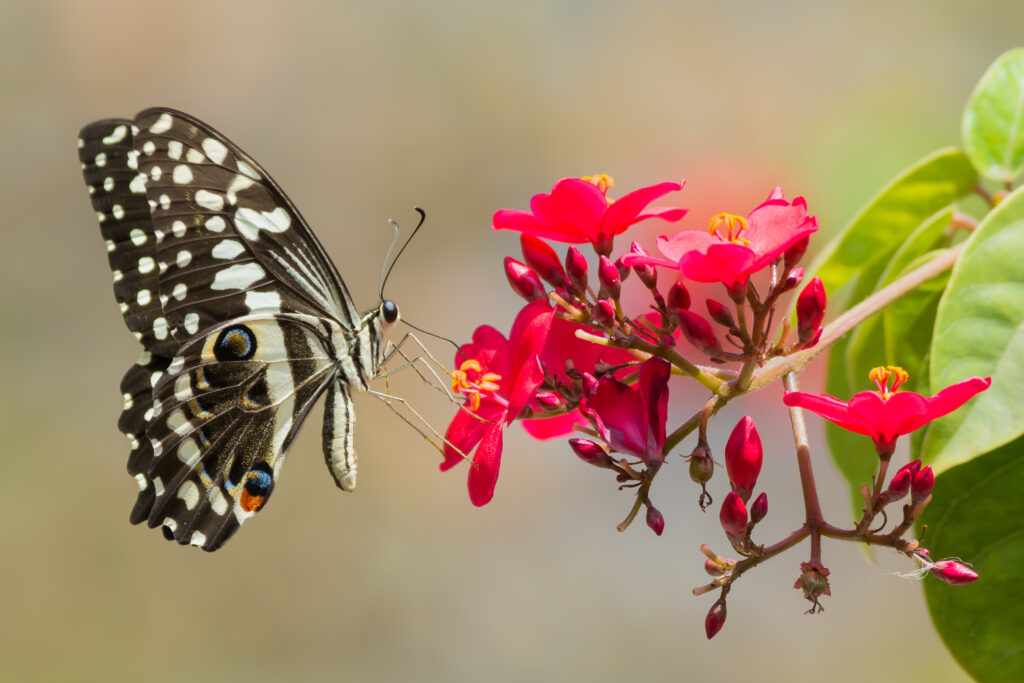
Speaking of pollinators with a sweet tooth, butterflies also enjoy delicious nectar. They have a long proboscis — their elongated mouth part — that allows them to reach deep inside the flower to get every drop of nectar that they desire. But this long mouth comes with the caveat of only eating foods in a liquid form, so butterflies basically drink all of their food like a smoothie. Their other favorites include honey, ripe fruit, rotting fruit, and tree sap that has been exposed by birds.
The fruit that they enjoy has to be pretty soft due to the aforementioned liquid diet, so butterflies mainly enjoy fallen fruit that haven’t been attached to trees for a while. Pears and apples seem to be the favorites, which makes sense considering how soft both of these fruits get when overripe.
Butterflies need natural sugar in order to thrive. If they do not consume nectar and sugary matter, they do not have the energy to continue pollinating our flowers. Butterflies are a major pollinator, just like bees, so we need them to be at their best in order to keep up the general health of the ecosystem. Butterflies are also similar to bees in that they have their own preferences for the flowers they visit. They gravitate more towards bright flowers because those are often the ones with the best nectar (we assume), which is why it’s common to find butterflies perched on the edges of vividly colored flowers in the spring and summer.
Fruit Flies
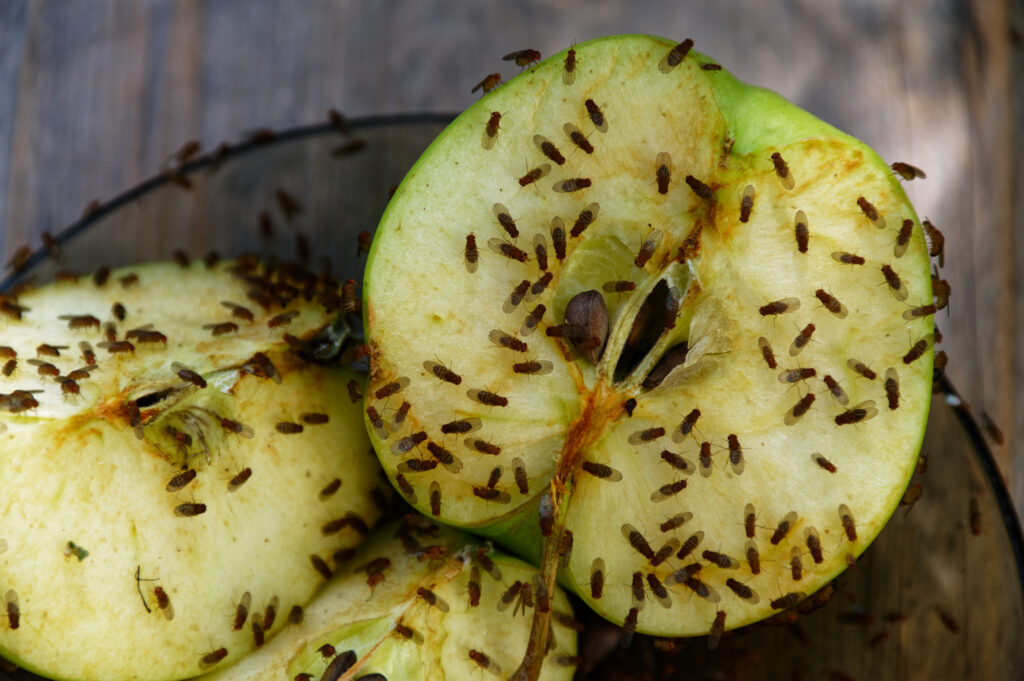
This one does not come as a surprise, given the name of this pest. Fruit flies live for overripe fruit because it’s their home and main food source. They also enjoy nectar and anything with fermentation, like leftover alcohol or juice. They have different taste receptors than other animals (like bees do), so they have a special love for anything sweet. There are about eight different sweet receptors in a fruit fly’s body, so they are able to taste more of the food than other insects.
These receptors make a fruit fly more sensitive to various sweets, so they also have a larger sweet tooth than most. They only live for up to two weeks, so fruit flies have to take all they can get with food. They also lay their eggs in overripe fruit to give their hatched larvae the best chance of survival with immediate food and shelter.
One fun fact about fruit flies is that they actually have similar taste receptors to those of mosquitoes! Male mosquitoes only consume nectar, so they have a similar sweet tooth. The mosquitoes responsible for our itchy bites are females that need protein for their eggs, which is the sector of taste receptors that fruit flies thankfully do not have.
Rodents
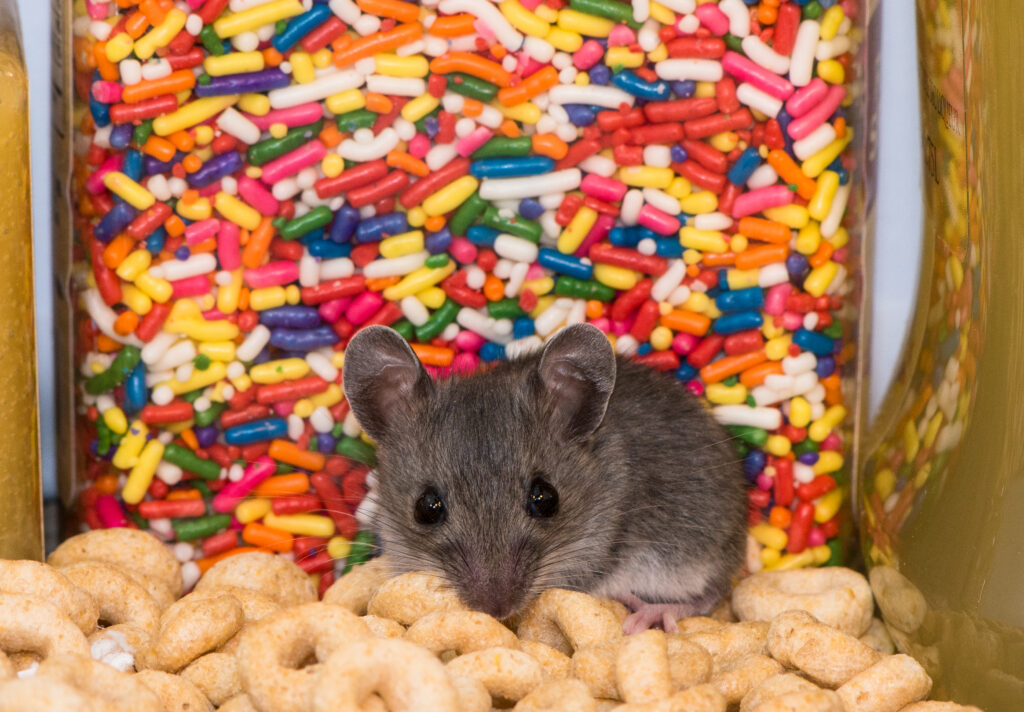
The largest pests on this list, rats and mice both have a major sweet tooth when it comes to the food they seek out. They forage for anything with lots of carbohydrates that will be both filling and energizing, which can include some sugary items. Candy and peanut butter are some notable favorites. Rats and mice also love chocolate, but it is actually poisonous for mice! There have been cases of people finding dead mice around the chocolate source, which has to be the only way to ruin the appeal of chocolate for us.
Rats and mice love sugar so much that they will even resort to invading a bag of actual sugar if they have access. Both rodents reproduce rapidly, so they are always foraging for food that they can bring back to their families. A pile of sugar crystals is the perfect energizing sustenance for a group of growing rodents!
This sweet tooth does not go away throughout their lives, hence why peanut butter has become a main bait for rodent traps. Gone are the days of cheese being the stereotypical bait, as peanut butter is now the DIY bait of choice for many homeowners. It may not always work, so we still recommend professional pest control for any kind of rodent invasion.
The Sweetest Victory is Calling Romney Pest Control!

There are two tasks you can do to prevent pests from finding your sugary treats and sticking around. One is to keep food in the same area, rather than dispersed throughout your home. If you do take your snacks or desserts in the living room to eat in front of the TV (we get it), make sure to throw away any trash and clean up all crumbs. If pests find remnants of food, they will start invading various rooms in search of their desired foods.
The other essential task is to keep all opened food sealed and properly stored when you’re done. Sealable plastic bags, pop-top plastic containers, and mason jars are all great ways to store opened snacks. The most important feature is that the container has a complete seal and doesn’t have any gaps that tiny pests can sneak through.
Even when you do these tasks, it is helpful to have preventative pest control in place already. It is much more productive and cost-efficient to prevent pests from entering at all than to get a handle on a full pest infestation. At Romney Pest Control, we are dedicated to solving all kinds of pest problems. Our knowledgeable technicians are here to solve your pest concerns during every season. Contact us to learn about our preventative pest treatments so you can enjoy your favorite treats without being interrupted by a pest invasion!
Citations
Brooks, D. (n.d.). Do mice like sugar? [..and how much!]. Mouse Trap Guide. Available at https://mousetrapguide.com/do-mice-like-sugar/ (Accessed on October 28, 2022).
Newcastle University. (2018, May 10). What gives bees their sweet tooth?. Phys Org. Available at https://phys.org/news/2018-05-bees-sweet-tooth.html (Accessed on October 28, 2022).
University of California – Riverside. (2014, January 13). How fruit flies detect sweet foods. ScienceDaily. Retrieved October 27, 2022 from www.sciencedaily.com/releases/2014/01/140113154217.htm
What are sugar ants and how do I get rid of them?. (n.d.). Ortho. Retrieved October 28, 2022, from https://www.ortho.com/en-us/library/bugs/what-are-sugar-ants-and-how-do-i-get-rid-them
What do bees eat?. (n.d.). Terminix. Retrieved October 28, 2022, from https://www.terminix.com/blog/bug-facts/what-do-bees-eat/
What do butterflies eat?. (2021, May 31). Peggy Notebaert Nature Museum. Retrieved October 28, 2022, from https://naturemuseum.org/2021/05/what-do-butterflies-eat/
What do butterflies eat and drink?. (n.d.). Wisconsin Pollinators. Retrieved October 28, 2022, from https://wisconsinpollinators.com/BU/BA_ButterflyDiet.aspx
What do pests and insects dine on?. (2018, September 4). Houseman Services. Retrieved October 28, 2022, from https://housemanservices.com/blog/what-do-pests-and-insects-dine-on/

